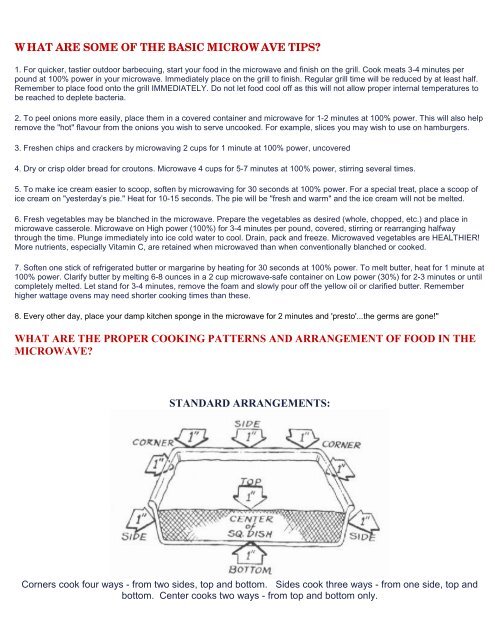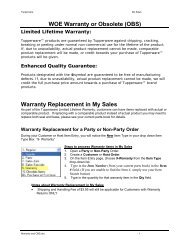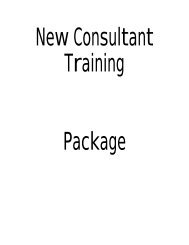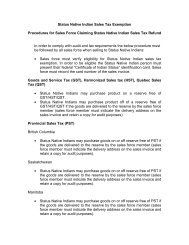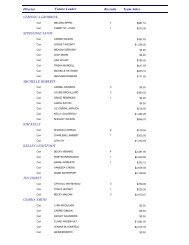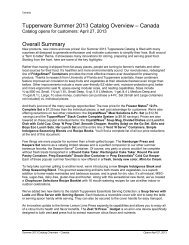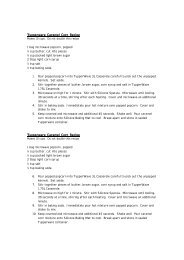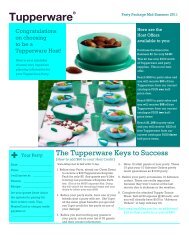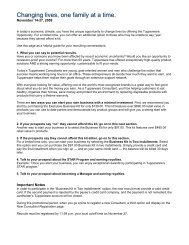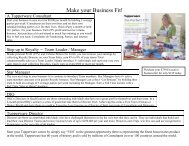Flyers Combined for Printing
Flyers Combined for Printing
Flyers Combined for Printing
Create successful ePaper yourself
Turn your PDF publications into a flip-book with our unique Google optimized e-Paper software.
WHAT ARE SOME OF THE BASIC MICROWAVE TIPS?<br />
1. For quicker, tastier outdoor barbecuing, start your food in the microwave and finish on the grill. Cook meats 3-4 minutes per<br />
pound at 100% power in your microwave. Immediately place on the grill to finish. Regular grill time will be reduced by at least half.<br />
Remember to place food onto the grill IMMEDIATELY. Do not let food cool off as this will not allow proper internal temperatures to<br />
be reached to deplete bacteria.<br />
2. To peel onions more easily, place them in a covered container and microwave <strong>for</strong> 1-2 minutes at 100% power. This will also help<br />
remove the "hot" flavour from the onions you wish to serve uncooked. For example, slices you may wish to use on hamburgers.<br />
3. Freshen chips and crackers by microwaving 2 cups <strong>for</strong> 1 minute at 100% power, uncovered<br />
4. Dry or crisp older bread <strong>for</strong> croutons. Microwave 4 cups <strong>for</strong> 5-7 minutes at 100% power, stirring several times.<br />
5. To make ice cream easier to scoop, soften by microwaving <strong>for</strong> 30 seconds at 100% power. For a special treat, place a scoop of<br />
ice cream on "yesterday’s pie." Heat <strong>for</strong> 10-15 seconds. The pie will be "fresh and warm" and the ice cream will not be melted.<br />
6. Fresh vegetables may be blanched in the microwave. Prepare the vegetables as desired (whole, chopped, etc.) and place in<br />
microwave casserole. Microwave on High power (100%) <strong>for</strong> 3-4 minutes per pound, covered, stirring or rearranging halfway<br />
through the time. Plunge immediately into ice cold water to cool. Drain, pack and freeze. Microwaved vegetables are HEALTHIER!<br />
More nutrients, especially Vitamin C, are retained when microwaved than when conventionally blanched or cooked.<br />
7. Soften one stick of refrigerated butter or margarine by heating <strong>for</strong> 30 seconds at 100% power. To melt butter, heat <strong>for</strong> 1 minute at<br />
100% power. Clarify butter by melting 6-8 ounces in a 2 cup microwave-safe container on Low power (30%) <strong>for</strong> 2-3 minutes or until<br />
completely melted. Let stand <strong>for</strong> 3-4 minutes, remove the foam and slowly pour off the yellow oil or clarified butter. Remember<br />
higher wattage ovens may need shorter cooking times than these.<br />
8. Every other day, place your damp kitchen sponge in the microwave <strong>for</strong> 2 minutes and 'presto'...the germs are gone!"<br />
WHAT ARE THE PROPER COOKING PATTERNS AND ARRANGEMENT OF FOOD IN THE<br />
MICROWAVE?<br />
STANDARD ARRANGEMENTS:<br />
Corners cook four ways - from two sides, top and bottom. Sides cook three ways - from one side, top and<br />
bottom. Center cooks two ways - from top and bottom only.
WHAT IS THE SIX-MINUTE-PER-POUND RULE?<br />
With but a few exceptions, foods (meats, poultry, vegetables and fruit) will cook to done in a full size oven (650-800 watts) at High<br />
power (100%) in 6 minutes per pound. An exception to this is fish and seafood, which take approximately 3-4 minutes per pound. In<br />
higher or lower wattage ovens, simply shorten or lengthen the cooking times slightly.<br />
When cooking is complete, allow food to stand 20-25% longer. Eighty percent of the cooking occurs in the microwave while it is on.<br />
After the microwave shuts off and during "standing time", food will cook 20-25% more. This is caused by the heat created by<br />
vibrating water molecules as they are slowing down to a stop. Remember, while molecules are moving, they are producing heat<br />
and will continue to cook our food. Standing time allows this "ongoing" cooking to complete, which is critical to cooking good food in<br />
the microwave. Do not cook foods until "done," it will be "overcooked" and tough after the standing time and "ongoing" cooking<br />
takes place.<br />
Cover food you remove from oven <strong>for</strong> "standing time" so heat will not escape.<br />
WHAT IS THE TEMPERATURE CORRELATION BETWEEN CONVENTIONAL AND<br />
MICROWAVE OVENS?<br />
Microwave oven power is measured in watts and indicates the intensity of which your oven will cook. Learn to relate your<br />
microwave "percentages of power" to your conventional "degrees of heat."<br />
Based on a microwave with 650-800 watts of power, the scale below shows how you can learn to relate your microwave<br />
"percentages of power" to your conventional oven's "degrees of heat."<br />
All heat measurements are in Fahrenheit.<br />
100 - 90% power 425 - 500 degrees, deep fat fry, broil or stove-top burner on "high"<br />
80% 375 - 425 degrees<br />
70% 350 - 375 degrees or medium-high on stove-top<br />
60 - 50% 300 - 350 degrees or medium on stove-top<br />
40 - 30% 225 - 300 degrees or medium-low on stove-top<br />
20% 200 - 225 degrees<br />
10% 150 - 200 degrees or lowest setting on stove-top<br />
BUYING, STORING AND KEEPING FOODS SAFE<br />
Did you know you should use cracked eggs only if thoroughly cooked to kill bacteria? Or, did you know roasts may be stored in the<br />
refrigerator <strong>for</strong> 5-6 days, but ground meats and stew meat only <strong>for</strong> 2 days? Or did you know hamburger should be frozen <strong>for</strong> only 4<br />
months, but roasts freeze successfully <strong>for</strong> a year?<br />
In<strong>for</strong>mation such as this, as well as how to pick and store perfect melons or mushrooms and all the other fruits and vegetables, are<br />
only a few of the facts covered in my books.
Microwave Cooking and Tupperware<br />
January, 2001<br />
Response to concerns regarding microwave cooking in plastic containers.<br />
Q. I've heard it is unsafe to microwave food in plastic products. Is this true?<br />
Tupperware products are safe. Health and safety are top priorities at Tupperware and<br />
all Tupperware products meet or surpass Federal government safety standards <strong>for</strong> food<br />
contact applications. All Tupperware products designed <strong>for</strong> use in the microwave are<br />
labeled on the bottom of the container and on the seals if they are to be used in the<br />
microwave. If the words, "microwave re-heatable" or "microwave cooking" or an icon<br />
showing short wavy lines appears on a Tupperware product, it has been designed to<br />
function safely in the microwave.<br />
Q. Are all Tupperware products safe to use in the microwave?<br />
Only Tupperware products specifically designed and recommended <strong>for</strong> use in the<br />
microwave should be used in the microwave. Tupperware is careful to specify which<br />
products are appropriate <strong>for</strong> microwave use and further specifies which of those<br />
microwave products are appropriate <strong>for</strong> cooking and which are appropriate <strong>for</strong> re-heating.<br />
Using the appropriate product not only results in optimal per<strong>for</strong>mance, but also prevents<br />
damage to our products. The high heats generated by foods prepared in a microwave can<br />
warp and melt non-microwave safe materials and microwave use would void the warranty.<br />
More importantly, this damage poses a safety hazard that could cause accidents and<br />
injuries to the user.<br />
Q. There have been stories in the media about the potential health risk<br />
associated with using plastic in the microwave. How can consumers be<br />
assured that Tupperware products are safe?<br />
All Tupperware products meet all applicable laws and regulations <strong>for</strong> product safety in<br />
each country where they are sold. The plastic materials, additives and colorants used in<br />
the manufacture of Tupperware food storage, preparation and serving products sold in<br />
the United States meet the requirements in the Regulations of the Food and Drug<br />
Administration of the United States of America. All colorants used in those products are<br />
registered on the French Positive List (Circular Letter No. 176), which is the most stringent<br />
in the world, and comply with the requirements of the Council of Europe Committee of<br />
Ministers Resolution AP (89) 1.<br />
Q. Are Tupperware products, not designated <strong>for</strong> use in the microwave, safe to<br />
use in the microwave?<br />
Though there are no known health risks, we recommend that you use only Tupperware<br />
products specifically designed <strong>for</strong> use in the microwave. Tupperware is careful to<br />
1
specify which products are appropriate <strong>for</strong> microwave use and further specifies which of<br />
those microwave products are appropriate <strong>for</strong> cooking and which are appropriate <strong>for</strong> reheating.<br />
Q. Do materials in Tupperware products migrate into food when re-heating or<br />
cooking in a microwave oven?<br />
The safety of plastic <strong>for</strong> food storage, preparation and serving containers has been<br />
confirmed many times by the U.S. Food and Drug Administration (FDA) - the government<br />
agency that regulates all products intended <strong>for</strong> direct and indirect contact with foods and<br />
beverages.<br />
Yes. All containers and cookware exhibit migration of materials into foods to some extent.<br />
This is seen in porcelain, crystal, aluminum, stainless steel, iron, tin, non-stick coatings<br />
and glass, as well as plastic. You may have seen the warnings to avoid using ceramics<br />
with glazes containing lead in food contact applications. As you can see, it is not the<br />
migration that is the concern, but the material and amount migrating. FDA sets the<br />
standard <strong>for</strong> what’s considered an acceptable level of migration – at parts per billion.<br />
None of our materials, additives or colorants are carcinogenic and there<strong>for</strong>e has no health<br />
effects in humans. Nor do migration levels of materials in our products exceed the levels<br />
permitted by law.<br />
Points related specifically to microwave cooking<br />
In a 1994 article entitled, The Hidden Hazards of Microwave Cooking, the author suggests<br />
that the process of microwaving food poses a serious health risk to humans. It claims<br />
microwave cooking causes “severe molecular damage” in food and when consumed<br />
causes “abnormal” changes in human blood and immune systems. The Q & A above is<br />
intended to help provide in<strong>for</strong>mation only about the safety of Tupperware microwave<br />
products, not microwave cooking.<br />
The following points are intended to in<strong>for</strong>m those who have concerns about the effects of<br />
microwave cooking on food and human health with in<strong>for</strong>mation based on 30 years of study<br />
and research.<br />
Microwave ovens heat food by oscillating waves of energy through food at a rate of<br />
2450 million times per second. As these waves pass through food, water and fat<br />
molecules generate heat caused by the friction produced by the waves. It is this<br />
friction that heats the food.<br />
Heating baby <strong>for</strong>mula in a microwave oven poses a risk due to the potential <strong>for</strong> the<br />
temperature to exceed an acceptable level <strong>for</strong> consumption by an infant. Microwaves<br />
tend to heat the upper parts of the liquid more than the lower parts. As a result,<br />
sections of the <strong>for</strong>mula will be hotter than other sections. It is recommended that you<br />
shake the bottle thoroughly and check the temperature be<strong>for</strong>e giving it to a child.<br />
2
Glass, paper and plastic are considered to be “transparent” to the microwave energy<br />
and cannot generate heat. Thus, the only way plastic containers can become heated<br />
is through food-contact. Conventional cooking in an oven happens just the opposite<br />
way. The hot air heats everything in the oven, including the container that holds the<br />
food.<br />
A microwave oven heats food in a more energy efficient manner than conventional<br />
cooking. In fact, some methods of conventional cooking can increase the presence of<br />
theoretically harmful substances, some of which are known to be mutagenic or even<br />
carcinogenic. There is no credible scientific evidence to support the conclusion that<br />
cooking in a microwave alters the molecular structure of food cells, thus reducing the<br />
nutritional value of food any more than conventional cooking.<br />
The Food and Drug Administration, one of the world’s most respected regulatory<br />
bodies, has conducted research on microwaves to assure that consumers would be<br />
safe. For 30 years, microwave ovens have been in use. More than 90% of American<br />
households now use microwave cooking to prepare food <strong>for</strong> their families – keep in<br />
mind heating food is widely considered an effective way of eliminating harmful<br />
organisms.<br />
Question & Answer<br />
Q. Do chemical or structural changes of any kind occur in food due to microwave<br />
cooking?<br />
No. Energy needed to change structure is much higher than can be supplied by a<br />
microwave. There are thermal (heat) effects on molecules and ions as a result of the wave<br />
action generated by microwaving. Friction of water and fat molecules contained in the<br />
food is what produces the heat.<br />
Q. Can any specific change in proteins and enzymes take place in microwave<br />
heated foods?<br />
Changes in protein and enzymes depend on temperature, not the source of heating. The<br />
energy required to damage these molecules is much higher than can be supplied by a<br />
microwave oven.<br />
Q. Can molecular changes occur in food?<br />
No. Energy needed to change molecular structure is much higher than can be supplied by<br />
a microwave.<br />
3
What you need to know about your microwave’s WATTAGE…<br />
The wattage of your microwave is the most important<br />
thing you need to know when you are doing any microwave<br />
cooking. It is just as important as knowing the oven<br />
temperature when you are baking.<br />
The AVERAGE WATTAGE of a microwave is 700-1200<br />
watts. This is the power that is the basis <strong>for</strong> cooking times in<br />
most microwave recipes, unless specified differently. This<br />
would be like an “average” oven temperature of 350 degrees.<br />
For comparison…<br />
700 Watts in microwave >> like cooking at 350 degrees<br />
800 Watts >> 450 degrees<br />
900 Watts >> 525 degrees (Self clean)<br />
1000 Watts >> 575 degrees<br />
1100 Watts >> 625 degrees (Blow torch!!)<br />
The big problem is that very few people know what the wattage of their<br />
microwave is, much less what to do to compensate <strong>for</strong> today’s high powered ovens.<br />
The “Tim Taylor Philosophy!” More power is not necessarily better.<br />
To find your oven’s wattage look on the inside of the door, on the back, or in<br />
“an under the hood fan” model, underneath<br />
For each 100 watts your microwave is over the average of 700, you should<br />
decrease EITHER the cooking TIME or POWER LEVEL by 10% (i.e. If you have a 100<br />
watt microwave, that is ~300 watts over the average. There<strong>for</strong>e, when following a<br />
recipe, cook on POWER 7 or 8, depending on the time of day.) Reverse <strong>for</strong> lower<br />
wattage (500 – 600) ovens.<br />
Remember – It takes two minutes to boil a mug of water in a 700watt<br />
oven. In a 1200-watt oven, it will take 45-50 seconds!! Two<br />
minutes on HIGH power is an eternity in a 1200-watt microwave!!
A Microwave Oven: is a six-sided metal box, with metal screen in door<br />
Microwaves are generated by the magnetron from behind control panel.<br />
From top down and outside into center<br />
Wattage: 700-725 watts is full-power microwave. Look <strong>for</strong> wattage on back of oven - -<br />
key word – WATTAGE (OR POWER) OUTPUT. Less than 625 watts just means longer<br />
cooking times. More wattage = less cooking time.<br />
-Turntable or no? . . If none, a rotating metal fan at top of oven to disperse<br />
microwaves evenly. Essentially no difference in cooking. Slight disadvantage with<br />
turntable -- limits size and shape of cookware.<br />
-Ovens built since early 1980’s have stringent manufacturing standards. SAFE! (as<br />
much chance of radiation as tanning by moonlight<br />
-Glass tray in the bottom of oven makes clean up easier, plus elevates food <strong>for</strong> more<br />
efficient cooking.<br />
Microwave Trivia: - A Microwave is 4 ½ inches long, ½ inch wide.<br />
Produced by magnetron, emitted at rate of 1 ½ billion per second. Travel<br />
at speed of light, only go 5 feet be<strong>for</strong>e dissipating. Too wide to go through<br />
holes in screen on door.<br />
-Microwaves are reflected off metal, pass through glass, Styrofoam, plastic, etc.<br />
-ONLY WATER, FAT, and SUGAR molecules absorb microwaves. Microwaves<br />
penetrate foods 1-1/2 inches and the energy absorbed cause molecules to rub<br />
together… creating FRICTION & HEAT… which cooks food.<br />
-STAND TIME – 20% of cooking time after timer done, during which food continues to<br />
cook.<br />
-If microwaves have nothing to work on, they will go back home to magnetron.<br />
There<strong>for</strong>e, never run microwave empty, including popping plain popcorn.<br />
-PEAK POWER CONSUMPTION PERIODS: Breakfast time, lunch, and suppertime.<br />
Not as much power available and you will find that during off times, foods will cook<br />
faster.<br />
Rules Of Thumb:<br />
1. The more dense the food, the longer to cook (e.g. Potatoes longer than<br />
broccoli). Liquids heat fastest, especially sugary and fatty ones.<br />
2. The smaller the pieces, the faster It will cook (e.g. Diced potatoes faster<br />
than baked)<br />
3. Liquids attract microwaves first, there<strong>for</strong>e always DRAIN BETWEEN<br />
BATCHES.<br />
4. Arrange thickest parts of food to outside of casserole. Cone in center if<br />
necessary.
Microwave MAGIC TRICK:<br />
Demonstrates use of foil in microwave, plus illustrates microwave EFFICIENCY vs.<br />
SAFETY<br />
You need – 2 Styrofoam cups, ½ cup chocolate chips, water, Tupperware Cone, a<br />
piece of Pyrex or Corning ware<br />
Fill one cup with cold water, other with chocolate chips. Wrap chips cup completely in<br />
foil (Shiny side or dull side irrelevant.)<br />
Temperature test water, chips, Cone, Pyrex. Place all in microwave, cook on High<br />
power 2.25 minutes. Temperature test again.<br />
CAUTION: If any arcing occurs, stop microwave IMMEDIATELY, and smooth out foil.<br />
FOIL USE Rules of thumb:<br />
1. Must have 4 times more EXPOSED food mass as foil mass.<br />
2. Keep foil 1 inch from sides of oven<br />
APPLICATIONS: - Large quantities of hamburger, defrost just what you need. Shield<br />
thin parts of chickens or hams. Use on corners of rectangular pans to deflect<br />
microwaves to center. Foil pie plates, T.V. dinners.<br />
SAFETY vs. EFFICIENCY: Many materials are microwave safe, very few are<br />
microwave efficient.<br />
-Being efficient means that energy and time are not wasted heating the container itself.<br />
-Pyrex, Corning Ware, Visions etc. all like to be hot first and longest. They contain<br />
metal (nickel) which creates ‘invisible light shows.’<br />
-20% cooking time is spent heating container, out of oven container draws heat from<br />
food.<br />
-To test at home: Place your container in microwave, (along with a cup of water to<br />
absorb microwaves), cook on High <strong>for</strong> 2-2.5 minutes. If container is not virtually the<br />
same temperature as when you put it in, it is not microwave efficient.<br />
ADVANTAGES OF TUPPERWAVE COOKWARE: Cuts cooking time by 15-20% over<br />
Corning etc.<br />
-Handles stay cool, no potholders needed. Food stays hot longer. Keep covered after<br />
cooking, TupperWave becomes a THERMO-INSULATOR. Stack-cook by weight to<br />
increase or decrease portions (6 min./lb. Of food)<br />
-Round casseroles with round corners <strong>for</strong> most even cooking. Bumps on bottom<br />
elevate, as well as interlock. Durable. Easy-clean, stain-resistant finish. Lightweight.<br />
Versatile. Non-Toxic. Lifetime Guarantee. Excellent customer service.
MICROWAVED CINNAMON PULL-APARTS<br />
¼ cup butter or margarine, melted in the bottom of a Large ROCK ‘N’ SERVE.<br />
1/3-cup brown sugar (or Brown sugar twin)<br />
1 pkg. Pillsbury Crescent Dough<br />
Nuts or raisins if desired<br />
Mix sugar & cinnamon into melted butter. Cut dough into ten rounds. Distribute over<br />
melted butter mixture, turning to coat. Sprinkle with raisins or nuts, if desired. Cover<br />
with Seal and vent. Microwave on High <strong>for</strong> 4-4 ½ minutes. Do not overcook! Enjoy!!<br />
MICROWAVED RICE KRISPIE SQUARES<br />
¼ cup butter or margarine 5 cups marshmallows 6 cups Krispies<br />
Melt butter in Large Deep Rock & Serve Container <strong>for</strong> 1 minute on High. Add in<br />
marshmallows, stirring to coat. Microwave on High <strong>for</strong><br />
1-½ minutes. Stir in Rice Krispies and 1 tsp. Vanilla until well blended. Wet hands and<br />
press into bottom of container. Cut with plastic knife (Sandwich Spreader) when cool.<br />
MICROWAVED ANGELFOOD CAKE<br />
½ box (1 ¼ cups) one step Angel food Cake Mix<br />
2/3-cup cold water<br />
Mix together in Large Mix and store Pitcher, <strong>for</strong> no more than 30-40 seconds, or just<br />
until well mixed. Do not over beat. Pour into ungreased Tupperware 3L casserole that<br />
has the Cone in it. Let stand 3 minutes. Cook on High power <strong>for</strong> 4-5 minutes. Do not<br />
overcook. Cake will still be sticky on top. Invert onto a tumbler or Snack Cup until cool.
in<br />
Life<br />
Microwave with care<br />
Avoid reheating foods in tubs and yogurt containers, experts advise<br />
TORONTO (Dec 30, 2005)<br />
Mary Anne McNally has been using a microwave <strong>for</strong> about a<br />
dozen years, mostly <strong>for</strong> reheating food, but she's picky about<br />
the kind of containers she'll put in the oven.<br />
Plastic containers, unless they're deemed microwave-safe, are<br />
a definite no-no.<br />
"My concern about that goes back a long way,'' said the<br />
Montreal homemaker. "When my step-daughter had her first<br />
child, who's now 15, her mother was a chemist at the University<br />
of Toronto, and she insisted . . . that her daughter get glass<br />
bottles <strong>for</strong> her grandson.<br />
CANADIAN PRESS<br />
While reheating food in the<br />
microwave is a quick, convenient<br />
way to use up leftovers, consumers<br />
should make sure the containers<br />
they use are safe.<br />
"She did not want him fed out of plastic bottles,'' said McNally, adding that they were difficult to find<br />
because "plastic was everywhere. But we succeeded.''<br />
Over the years, persistent reports that some plastics could leach potentially toxic chemicals into food<br />
during microwaving lent support to McNally's concern about the ubiquitous containers.<br />
"For instance, a yogurt container or a margarine container'' are verboten when it comes to the<br />
microwave, she said. "I'll store food in that and then I'll transfer it be<strong>for</strong>e I microwave it.''<br />
It turns out McNally has good reason to be cautious when it comes to certain plastic containers and<br />
food wraps, scientists confirm.<br />
Many plastic products contain "plasticizers,'' which allow the material to be flexible and less brittle,<br />
said biologist Rolf Halden, a public health scientist at the Johns Hopkins School of Public Health.<br />
"There is no doubt that plastics over time will give off some of these plasticizers,'' Halden said from<br />
Baltimore, Md. "What people need to be aware of is that plastics are manufactured <strong>for</strong> a particular<br />
purpose. And oftentimes consumers, just out of convenience, use things <strong>for</strong> not intended uses."<br />
In other words, those handy little tubs that once held such victuals as yogurt, margarine or pudding<br />
should never get zapped behind the microwave door -- and the same is true of take-out food<br />
containers made of Styrofoam, a substance that isn't heat-stable.<br />
Unless a product has been tested and certified microwave-safe, it should not be used to cook or<br />
reheat food in the microwave, Halden said.<br />
SOURCE: HEALTH CANADA<br />
an obvious problem, or you could allow <strong>for</strong> excessive migration of chemicals from the container into
+ Visit NASA.gov + Science@NASA + IMAGERS Home<br />
RADIO WAVES | MICROWAVES | INFRARED | VISIBLE LIGHT | ULTRAVIOLET | X-RAYS | GAMMA RAYS<br />
Microwaves have wavelengths that<br />
can be measured in centimeters! The<br />
longer microwaves, those closer to a<br />
foot in length, are the waves which<br />
heat our food in a microwave oven.<br />
Microwaves are good <strong>for</strong> transmitting<br />
in<strong>for</strong>mation from one place to another<br />
because microwave energy can<br />
penetrate haze, light rain and snow,<br />
clouds, and smoke.<br />
Shorter microwaves are used in<br />
remote sensing. These microwaves<br />
are used <strong>for</strong> radar like the doppler<br />
radar used in weather <strong>for</strong>ecasts.<br />
Microwaves, used <strong>for</strong> radar, are just<br />
a few inches long.<br />
Microwaves<br />
This microwave tower can transmit in<strong>for</strong>mation like telephone calls and computer data from one city to another.<br />
How do we "see" using Microwaves?<br />
Radar is an acronym <strong>for</strong> "radio detection and ranging". Radar was developed to detect objects and determine their range (or position) by<br />
transmitting short bursts of microwaves. The strength and origin of "echoes" received from objects that were hit by the microwaves is then<br />
recorded.


